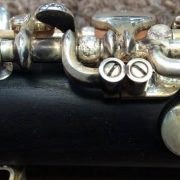Post 59: High Acidic Skin Levels And Your Oboe
We get asked all the time about keeping oboes clean and shiny. A lot of the “cleaning” aspects revolve around dust, reed shavings and potential food particles that can make their way into and onto the oboe. All of these aspects can easily be addressed by having an annual cleaning at Onks Woodwind. See our annual cleaning post here.
There is another aspect to keeping your oboe clean that is sometimes very difficult to keep under control and that is tarnish! Tarnish is a chemical reaction between a metal and nonmetal compound. When talking about oboes, the main compounds involved are typically the plated metal on keys and posts, oxygen and moisture. With these basic, most common compounds, normally it isn’t too difficult to keep your oboe clean and shiny. Simply having a plain, non-abrasive cloth to occasionally wipe down the oboe keys should do the trick. (Note: You can also use an actual silver polish cloth, but it’s not 100% necessary.)
Occasionally, we have clients that have severe tarnish build-up on their keys and posts, and in these cases we have to take a little closer look. There are many factors related to the development of tarnish and these factors can change from person to person. One of the factors revolves around the pH or acidic level of our skin. The normal acidic level on human skin is between 4.1-5.8*, which is somewhat acidic. A level of 7 is neutral. Our skin wants to be acidic to help fight off unwanted germs which is a good thing, but a bad thing for our oboes.
The pH levels will vary from person to person and these variances can be attributed to our race, medicines, medical conditions, soaps and topical leave-on products like cosmetics and lotions. Understanding our bodies physiology, all the products we come in contact with and the effects this has on our oboe is, to say the least, complicated!
So what are we to do with this information? We will keep it simple! We have always suggested to our clients to wash their hands right before playing to help keep their oboes clean in general. This will reduce food particles/residue and will also reduce the amount of natural acid, oils and perspiration from getting on the oboe. In turn, this will help reduce the chemical reaction of tarnish forming on your oboe keys and posts. If you use cosmetics, lotions, hair products, etc. and apply these products with your hands, wash your hands thoroughly before assembling your oboe.
Sometimes this is not enough. Many musicians performing in highly stressful conditions or in hot venues will tend to perspire continuously throughout their performance. Some musicians simply perspire a lot, no matter the performance conditions. In these circumstances, we recommend the musician keep an extra towel handy so they can wipe off their hands during a performance to keep their hands and oboe as clean as possible. If you are performing in a concert that has an intermission, make sure you go out and wash your hands again.
(Note: If you perform regularly with different dress codes, we recommend you go out and purchase different colored hand towels so they blend in with the environment better. Standard bathroom hand towels are usually available in multiple colors and are not too big or small to handle the task.)
Once you are finished playing, wash your hands again, if possible, before putting your oboe away. As you’re swabbing or feathering out your oboe, wipe it down again with a non-abrasive, lint free cloth to get any remaining fingerprints and perspiration off of the oboe.
If you do get tarnish, what can be done about it? In the pictures below, you will see a couple of different levels of tarnish. The light brown tarnish is fairly mild and can be hand polished off with a silver polish cloth. This can be done in part just by wiping the keys while they are on the oboe, but to have a complete polish, the oboe will need to be disassembled. Onks Woodwind can do this as part of an annual cleaning to make your oboe look and play better than new.
The dark black tarnish is very heavy tarnish and cannot be hand polished off. In these instances the oboe would have to be disassembled and the keys would have to be buffed with a powered motor. The keys on the oboe in this picture could mostly be buffed and shined up without replacing the pads since the heavy tarnish is not around the pad cups. Many oboes, however, get heavy tarnish all over the keys after years of usage and in that scenario, the oboe would require a full mechanical overhaul to remove the tarnish as a buffing machine would destroy the pads and corks.


In closing, your oboe will thank you if you take care to wash your hands and lightly wipe down the oboe after you play it. Also take stock of the cosmetics and lotions you use as they can help promote tarnish as much as your natural physiology. As always, if you have questions or concerns don’t hesitate to contact us.
*Please note we are not scientists. We did refer to a physician who helped explain pH and provided the accompanying dermatological article.



